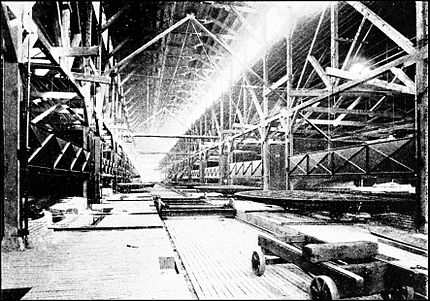inches. It is almost needless to say that the sole fuel used in all these works is natural gas. It has, indeed, made possible their large extension and success. At Ford City alone contracts were recently given for the drilling of seven wells at the same time.
In the second producer of glass in the United States, New Jersey, there has also been a continuity of operation not met with elsewhere. The early factories of Salem County and at Glassboro were the nucleus of a large and thriving glass settlement. The very favorable natural conditions early made the State the center of the bottle trade. Many of the works established during the first half of the century went out of existence after a few years'

Interior View of the Grinding Hall at Ford City, Pa.
more or less successful run. But others, such as the works established at Millville in 1822, continue among the most important in the State. The introduction of anthracite as a fuel does not seem to have been made until 1856, though even at the present time wood is largely used in the annealing ovens. The weakest element in the New Jersey glass industry lies right here, in her deficient fuel. With various town corporations in Ohio and elsewhere offering natural gas free to glass-producers, the competition is very unequal, for the manufacture of bottles requires no great purity in the sand and no very special skill in the blower. Yet this rivalry appears to have been successfully met, for there has been during recent years a marked increase in the output of

